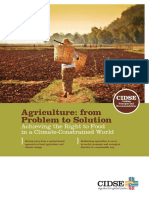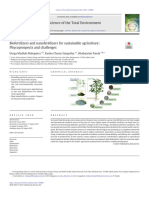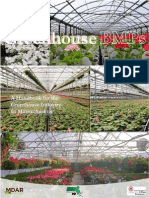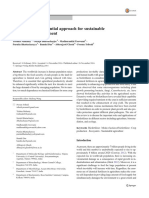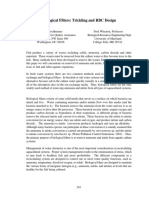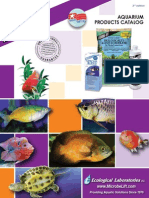Course Reader Week 3 Extra
Uploaded by
pirateCourse Reader Week 3 Extra
Uploaded by
pirateedX course
MOOC
Aquaponics - the circular food production system
Course reader
Week 3 Extra – Aquaculture Part 2
ZHAW Zurich University of Applied Sciences, Wädenswil, Switzerland
Based on and adapted from Junge, R., Antenen, N., Villarroel, M., Griessler Bulc, T., Ovca, A., &
Milliken, S. (Eds.) (2020). Aquaponics Textbook for Higher Education. Zenodo.
http://doi.org/10.5281/zenodo.3948179
Course Reader Week 3 EXTRA – Biogeochemical cycles 1
Content
1 MACRO- AND MICRONUTRIENTS ......................................................................................................... 3
1.1 The elements of the universe ............................................................................................................. 3
1.2 Macro- and micronutrients and their roles in organisms .................................................................... 4
2 THE BIOGEOCHEMICAL CYCLES OF MAJOR NUTRIENTS IN AQUAPONICS ................................. 6
2.1 The nitrogen cycle .............................................................................................................................. 6
2.2 The Phosphorus cycle ...................................................................................................................... 10
3 REFERENCES ........................................................................................................................................ 11
Course Reader Week 3 EXTRA – Biogeochemical cycles 2
1 Macro- and micronutrients
1.1 The elements of the universe
There are 92 naturally occurring elements on the Earth. Some are very well studied, some not at all: for
example astatine (Bryson 2003). The problem is that some elements are very rare. For example, only
24.5 grams of francium occur at any time in the whole of the Earth’s crust. Only about 30 of the
naturally occurring elements are widespread on Earth, and very few are important for life (Figure 1). In
the solar system, stars in general, and probably the entire universe, the most abundant elements are the
lighter elements: over 75% hydrogen (H), 25 % helium (He), about 1% everything else. In the 'everything
else' category even numbered elements are more abundant than odd numbered elements. Abundance
tends to fall rapidly with increasing atomic number. However, carbon (C), oxygen (O), magnesium (Mg),
silicon (Si), and iron (Fe) are anomalously high relative to these general trends, while lithium (Li),
beryllium (Be), and boron (B) are anomalously low. In the Earth's crust the order of abundance is O (<
50%), Si (> 20%), Al, Fe, Mg, Ca, Na, and K. These are all elements that rocks are mostly made of. In the
Earth as a whole, because of the core and the mantle, Fe, Ni, and Mg, become more common, while O,
Si, Al remain major overall constituents (Table 1). Concerning life, elements have different functions
(Table 2). We have evolved to utilize or tolerate the elements, but we live within narrow ranges of
acceptance. As a rule, our tolerance for elements is directly proportionate to their abundance in the
Earth’s crust (Bryson 2003).
Figure 1: The distribution of naturally occurring elements known or believed to be essential for life in the periodic
table. The understanding of the ecological importance of C, N, and P is much more advanced than it is for the other
elements (redrawn after Da Silva & Williams 2001).
Course Reader Week 3 EXTRA – Biogeochemical cycles 3
Table 1: The occurrence of elements in % dry weight of the Earth crust, green algae and animals (data from
different sources) in comparison with lettuce grown in a hydroponic system, and fish feed (Schmautz, unpublished
data). Note that the frequency (and with that the availability) of elements in the Earth crust does not match the
frequency in living beings.
1.2 Macro- and micronutrients and their roles in organisms
Chemical elements have different roles and are mainly involved in different functions in an organism
(Table 2). Organisms do not require all these elements in the same quantities. Some elements are
required in large quantities, while others are required in minute quantities. This is illustrated nicely by
the tentative stoichiometric formula for a living human being (Sterner & Elser 2002):
𝐻375,000,000 𝑂132,000,000 𝐶85,700,000 𝑁6,430,000 𝐶𝑎1,500,000 𝑃1,020,000 𝑆206,000 𝑁𝑎183,000 𝐾177,000
𝐶𝑙127,000 𝑀𝑔40,000 𝑆𝑖38,600 𝐹𝑒2,680 𝑍𝑛2,110 𝐶𝑢76 𝐼14 𝑀𝑛13 𝐹13 𝐶𝑟7 𝑆𝑒4 𝑀𝑜3 𝐶𝑜1
This means that for every cobalt (Co) atom in our body, there are 132 million oxygen (O) atoms. The
major nutritional requirements of plants and animals, without which they are unable to complete a
normal life cycle, are outlined in Figure 2. Macronutrients are required in larger quantities.
Micronutrients are required in minute quantities.
Course Reader Week 3 EXTRA – Biogeochemical cycles 4
Table 2: Primary functions and the chemical elements (or associated ions) involved in performing them for
organisms (modified from Sterner & Elser 2002). Elements with a relatively minor role are indicated in
parentheses.
Function Elements Chemical form Examples
Structural (biological H, O, C, N, P, S, Si, B, Involved in chemical • Biological molecules (proteins,
polymers and F, Ca, (Mg), (Zn) compounds or DNA, fats, carbohyxdrates)
support materials) sparingly soluble • Tissues (muscle, lung, leaves…)
inorganic compounds • Skeletons; shells; teeth
• Plant support tissues (lignine,
cellulose)
Electrochemical H, Na, K, Cl, HPO42-, Free ions • Message transmission in nerves
(Mg), (Ca) • Cellular signalling
• Energy metabolism
Mechanical Ca, HPO42-, (Mg) Free ions exchanging • Muscle contraction
with bound ions
Catalytic (acid-base) Zn, (Ni), (Fe), (Mn) Complexed with • Digestion (Zn). Zinc oxidises
enzymes alcohol.
• Hydrolysis of urea (Ni)
• PO4 removal in acid media (Fe,
Mn)
Catalytic (redox) Fe, Cu, Mn, Mo, Se, • Reactions with O2 (Fe, Cu)
(Co), (Ni), (V) • Nitrogen fixation (Mo)
• Reduction of nucleotides (Co)
• Co is necessary for the creation
of Vitamin B12
Figure 2: Nutritional requirements of plants and animals. Note that water (needed by all living beings) is not
included in the chart. Animals obtain their nutrients from feed and drink. Plants, with the exception of parasitic
and carnivorous ones, absorb the essential nutrient elements from their environment (air, soil solution, nutrient
solution).
Course Reader Week 3 EXTRA – Biogeochemical cycles 5
2 The biogeochemical cycles of major nutrients in aquaponics
2.1 The nitrogen cycle
Nitrogen is an essential element for all living organisms and is the main nutrient of concern in
aquaponics. It occurs in amino acids (parts of proteins), nucleic acids (DNA and RNA), and in the energy
transfer molecule adenosine triphosphate (Pratt & Cornely 2014). As nitrogen occurs in many chemical
forms, the nitrogen cycle is very complex (Figure 3).
Figure 3: The general form of nitrogen cycle (Encyclopaedia Britannica)
Course Reader Week 3 EXTRA – Biogeochemical cycles 6
The majority of Earth's atmosphere (78%) is atmospheric nitrogen gas, which is molecular dinitrogen
(N2). Nitrogen gas is very non-reactive and of no-use for most organisms. Nitrogen fixation are all
processes that convert atmospheric nitrogen gas into compounds that can be termed reactive nitrogen
(Nr). Nr includes all biologically active, photochemically reactive, and radiatively active N compounds in
the atmosphere and biosphere. It includes inorganic reduced forms of N (e.g. NH3 and NH4+), inorganic
oxidized forms (e.g., NOx, HNO3, N2O, and NO3–), and organic compounds (e.g., urea, amines, and
proteins) (Galloway et al. 2008).
Nitrogen fixation can occur naturally by lightning, as the very hot air breaks the bonds of N2, thus
starting the formation of nitrous acid. It can be performed chemically in a reaction called the Haber-
Bosch process. Biological nitrogen fixation occurs when N2 is converted to ammonia by an enzyme called
a nitrogenase. Microorganisms that fix N2 are mostly anaerobic. Most legumes (beans, peas, etc.) have
nodules in their root systems that contain symbiotic bacteria called rhizobia that help the plant to grow
and compete with other plants. When the plant dies, the fixed nitrogen is released, making it available
to other plants.
Figure 4 shows the nitrogen cycle as it occurs in aquaponics. In aquaponics two parts of the food chain
(primary producers and consumers) which usually occur together are spatially separated into the
aquaculture and hydroponic compartments. The synergistic effects that allow for efficient nutrient
utilisation are mediated by microorganisms.
Figure 4: The nitrogen cycle in aquaponics.
Nitrogen enters the aquaponic system via fish feed, which is ingested by fish and later excreted as total
ammonia nitrogen (TAN, ammonia - NH3 and ammonium – NH4+) (Wongkiew et al. 2017). The nitrogen is
converted to either ammonium (NH4+) under acidic or neutral pH conditions, or ammonia (NH3) at
higher pH levels. The ammonia concentration is dependent on the ammonium content, pH and
temperature (Figure 5, Table 3). Ammonia is less soluble in water than NH4+; therefore, NH3 is rapidly
converted to a gaseous form and emitted from the water (Gay & Knowlton 2009).
Course Reader Week 3 EXTRA – Biogeochemical cycles 7
Whilst ammonium (NH4+) is not toxic for fish, ammonia (NH3) is. Therefore, TAN ought to be removed
from the system water and ideally converted to nitrate for two reasons: (i) ammonia and nitrite, a
secondary product of nitrification, are both harmful to fish, while nitrate is tolerated by the fish up to
150-300 mg/L (Graber & Junge 2009); (ii) TAN is not optimal for plants, which require predominantly
nitrates or a mix of ammonium and nitrate for growth (Hu et al. 2015). This process of biological
oxidation of ammonia or ammonium to nitrite followed by the oxidation of the nitrite to nitrate is called
nitrification and mostly takes place in the biofilter of aquaponic systems (Table 4). Nitrification is an
aerobic process performed by small groups of autotrophic bacteria and archaea and was discovered by
the Russian microbiologist Sergei Winogradsky (1892).
Figure 5: Ammonia-ammonium equilibrium as a function of different temperatures and pH
(source: Cofie et al., 2016).
Table 3: Percentage (%) of un-ionized ammonia in aqueous solution at different pH values and
temperatures. To calculate the amount of un-ionized ammonia present, the Total Ammonia Nitrogen (TAN)
concentration must be multiplied by the appropriate factor selected from this table using the pH and
temperature from your water sample and divided by 100. If the resulting concentration is larger than 0.05
mg/L the ammonia is harming the fish (adapted after Francis-Floyd et al. 2009).
Table 4: Chemical equations of nitrification. Nitrification is usually a two-step process, performed by a specialised
group of bacteria, called nitrifiers.
Equation Involved bacteria
𝑁𝐻4+ + 1.5 𝑂2 → 𝑁𝑂2− +
+ 2 𝐻 + 𝐻2 𝑂 + 𝑒𝑛𝑒𝑟𝑔𝑦 nitritation; ammonia oxidizing bacteria (AOB)
𝑁𝑂2− + 0.5 𝑂2 → 𝑁𝑂3− + 𝑒𝑛𝑒𝑟𝑔𝑦 nitratation; nitrite oxidizing bacteria (NOB)
𝑁𝐻4+ + 2.0 𝑂2 → 𝑁𝑂3− + 2 𝐻 + + 𝐻2 𝑂 + 𝑒𝑛𝑒𝑟𝑔𝑦 nitrifiers
Course Reader Week 3 EXTRA – Biogeochemical cycles 8
The transformation of ammonia to nitrite is usually the rate limiting step of nitrification. This is because
AOB (bacteria of the genus Nitrosomonas, Nitrosospira, Nitrosovibrio sp., etc.) and NOB (bacteria of the
genus Nitrobacter, Nitrospira, Nitrococcus, etc.) have different growth rates, causing partial nitrification,
especially during the start-up period, leading to NO2- accumulation until nitrifiers are fully established,
which can take up to 4 weeks (Figure 6).
Denitrification (Table 5) is conversion of nitrate (NO3-) to nitrite (NO2-), nitric oxide (NO), nitrous oxide
(N2O) and finally to nitrogen gas (N2) under anoxic and anaerobic conditions (very low or zero levels of
dissolved oxygen). Denitrification is carried out by dentrifiers, who belong to taxonomically different
groups of archaea and facultative heterotrophic bacteria. As N2O is a more potent greenhouse gas than
CO2, its production has to be reduced to a minimum (Zou et al. 2016) in order to maximize the rates of
incorporation of N into plant biomass.
Figure 6: Starting the biofilter: development of ammonia, nitrite, and nitrate concentrations over time. (LECA
denotes Light Expanded Clay Aggregate, an often used medium in hydroponic.)
Table 5: Chemical equations of denitrification reactions. Denitrification generally proceeds through some
combination of the following half reactions, with the enzyme catalysing the reaction in parentheses
Equations Enzyme catalysing the reaction
𝑁𝑂3− + 2 𝐻 + + 2 𝑒 − → 𝑁𝑂2− + 𝐻2 𝑂 Nitrate reductase
𝑁𝑂2− + 2 𝐻 + + 𝑒 − → 𝑁𝑂 + 𝐻2 𝑂 Nitrite reductase
2 𝑁𝑂 + 2 𝐻 + + 2 𝑒 − → 𝑁2 𝑂 + 𝐻2 𝑂 Nitric oxide reductase
𝑁2 𝑂 + 2 𝐻 + + 2 𝑒 − → 𝑁2 + 𝐻2 𝑂 Nitrous oxide reductase
2 𝑁𝑂3− + 12 𝐻 + + 10 𝑒 − → 𝑁2 + 6 𝐻2 𝑂 The complete process can be
expressed as a net balanced redox
reaction
Anaerobic ammonium oxidation (anammox). The bacteria mediating this process were identified in
1999 (Strous et al. 1999). Anammox could exist in aquaponic systems because the water characteristics
are similar to those in aquaculture systems, where the anammox process has been shown to occur
(Wongkiew et al. 2017). However, the anammox rate is 10-fold slower than the nitrification rate. The
anammox process has been reported to contribute to nitrogen loss in different ecosystems (Burgin &
Course Reader Week 3 EXTRA – Biogeochemical cycles 9
Hamilton 2007, Hu et al. 2010). Since ammonia and nitrite are available in aquaponic systems, nitrogen
gas could be formed via the anammox process under anoxic conditions in the biofilter (Table 6).
Table 6: Chemical equation of annamox reaction
Equation Involved bacteria
𝑁𝐻4+ + 𝑁𝑂2− → 𝑁2 + 2 𝐻2 𝑂 + 𝑒𝑛𝑒𝑟𝑔𝑦 anammox bacteria
2.2 The phosphorus cycle
Phosphorus (P) is the second most important macronutrient for plant growth and it is required in
relatively large amounts. It plays a role in respiration and cellular division and is used in the synthesis of
energy compounds. P enters the aquaponic system by the way of fish feed, tap water, and fertilizer
additions (if applicable). The chemical form in which P is present in the nutrient solution depends on the
pH. The pKs (quantitative measure of acidity) for the dissociation of H3PO4 into H2PO4- and then into
HPO42- are 2.1 and 7.2 respectively (Schachtman et al. 1998, cited in da Silva Cerozi & Fitzsimmons
2016). Therefore, in the pH range maintained in aquaponic systems, P is mostly present in the form
H2PO4-, and less as H3PO4 or HPO42-. Plants can only absorb P as the free orthophosphate ions H2PO4- and
HPO42-. Experimental and simulation studies have shown that P availability decreases with increasing pH
of aquaponic water due to precipitation (Figure 7).
If the pH in aquaponic nutrient solution increases, P binds to several cations, so that fewer free P ions
(PO4) are available in solution, but there are more insoluble calcium phosphate species, which
precipitate from the solution. These insoluble complexes can accumulate either in the fish sludge
(Schneider et al. 2005) or in the sediments and periphyton on the walls and piping of the aquaponic
system. Yogev et al. (2016) estimated that this loss can be up to 85%. One option to prevent this
massive loss of P via sludge is to add a digestion compartment to the aquaponic system. During aerobic
or anaerobic digestion, the P is released into the digestate and can be re-introduced into the circulating
water (Goddek et al. 2016). Da Silva Cerozi & Fitzsimmons (2016) also demonstrated the importance of
organic matter and alkalinity in keeping free phosphate ions in solution at high pH ranges. It is
recommended though that pH in aquaponic systems is maintained at a range of 5.5–7.2 for optimal
availability and uptake by plants.
Course Reader Week 3 EXTRA – Biogeochemical cycles 10
Figure 7: Speciation of the major forms of P in aquaponic solution as a function of pH as simulated in Visual
MINTEQ. Note that not all PO4 species are described in the chart (from da Silva Cerozi & Fitzsimmons 2016).
The precise dynamics of phosphorus in aquaponics is still not understood. The main input of phosphorus
in the system is the fish feed, and in un-supplemented systems phosphorus tends to be limiting (Graber
& Junge 2009; Seawright et al. 1998). This is also the reason why up to 100% of phosphorus present in
the fish water can be recycled in the plant biomass, depending on the design of the system (Graber &
Junge 2009).
3 References
Bryson, B. 2003. A Short History of Nearly Everything. Doubleday, London.
Burgin, A.J. and Hamilton, S.K. 2007. Have we overemphasized the role of denitrification in aquatic
ecosystems? A review of nitrate removal pathways. Frontiers in Ecology and the Environment 5 (2), 89-
96.
Cofie, O., Nikiema, J., Impraim, R., Adamtey, N., Paul, J. and Koné, D. 2016. Co-composting of Solid
Waste and Fecal Sludge for Nutrient and Organic Matter Recovery. Colombo, Sri Lanka: International
Water Management Institute (IWMI). CGIAR Research Program on Water, Land and Ecosystems (WLE).
47p. (Resource Recovery and Reuse Systems Series 3).
da Silva Cerozi, B. & Fitzsimmons, K. 2016. The effect of pH on phosphorus availability and speciation in
an aquaponics nutrient solution. Bioresource Technology 219, 778-781.
da Silva, J.F. & Williams, R.J.P. 2001. The Biological Chemistry of the Elements: The Inorganic Chemistry
of Life. Oxford University Press, Oxford.
Francis-Floyd, R., Watson, C., Petty, D. & Pouder, D.B. 2009. Ammonia in Aquatic Systems. University of
Florida, IFAS Extension. Publication #FA 16.
Galloway, J.N., Townsend, A.R., Erisman, J.W., Bekunda, M., Cai, Z., Freney, J.R., Martinelli, L.A.,
Seitzinger, S.P. & Sutton, M.A. 2008. Transformation of the nitrogen cycle: recent trends, questions, and
potential solutions. Science 320 (5878), 889-892.
Gay, S.W. & Knowlton, K.F. 2009. Ammonia Emissions and Animal Agriculture. Virginia Cooperative
Extension (VCE) Publications, No. 442-110.
Course Reader Week 3 EXTRA – Biogeochemical cycles 11
Goddek, S., Schmautz, Z., Scott, B., Delaide, B., Keesman, K.J., Wuertz, S. & Junge, R. 2016. The effect of
anaerobic and aerobic fish sludge supernatant on hydroponic lettuce. Agronomy 6 (2), 37.
Graber, A., & Junge, R. 2009. Aquaponic systems: Nutrient recycling from fish wastewater by vegetable
production. Desalination 246 (1-3), 147-156.
Hu, B.L., Zheng, P., Tang, C.J., Chen, J.W., van der Biezen, E., Zhang, L., Ni, B.J., Jetten, M.S., Yan, J., Yu,
H.Q. & Kartal, B. 2010. Identification and quantification of anammox bacteria in eight nitrogen removal
reactors. Water Research 44 (17), 5014-5020.
Hu, Z., Lee, J.W., Chandran, K., Kim, S., Brotto, A.C. & Khanal, S.K. 2015. Effect of plant species on
nitrogen recovery in aquaponics. Bioresource Technology 188, 92-98.
Pratt, C.W. & Cornely, K. 2014. Essential Biochemistry (3rd edition). John Wiley and Sons Inc., MA.
Schachtman, D.P., Reid, R.J. & Ayling, S.M. 1998. Phosphorus uptake by plants: from soil to cell. Plant
Physiology 116 (2), 447-453.
Schneider, O., Sereti, V., Eding, E.H. & Verreth, J.A.J. 2005. Analysis of nutrient flows in integrated
intensive aquaculture systems. Aquacultural Engineering 32 (3-4), 379-401.
Seawright, D.E., Stickney, R.R. & Walker, R.B. 1998. Nutrient dynamics in integrated aquaculture–
hydroponics systems. Aquaculture 160, 215–237.
Sterner, R.W. & Elser, J.J. 2002. Ecological Stoichiometry: The Biology of Elements from Molecules to the
Biosphere. Princeton University Press.
Strous, M., Fuerst, J.A., Kramer, E.H., Logemann, S., Muyzer, G., van de Pas-Schoonen, K.T., Webb, R.,
Kuenen, J.G. & Jetten, M.S. 1999. Missing lithotroph identified as new planctomycete. Nature 400
(6743), 446.
Winogradsky, S. 1892. Contributions à la morphologie des organismes de la nitrification. Arch. Sci.
Biol. 1, 87–137.
Wongkiew, S., Hu, Z., Chandran, K., Lee, J.W. & Khanal, S.K. 2017. Nitrogen transformations in aquaponic
systems: A review. Aquacultural Engineering 76, 9-19.
Yogev, U., Barnes, A. & Gross, A. 2016. Nutrients and energy balance analysis for a conceptual model of
a three loops off grid, aquaponics. Water 8 (12), 589.
Zou, Y., Hu, Z., Zhang, J., Xie, H., Liang, S., Wang, J. & Yan, R. 2016. Attempts to improve nitrogen
utilization efficiency of aquaponics through nitrifies addition and filler gradation. Environmental Science
and Pollution Research 23 (7), 6671-6679.
Course Reader Week 3 EXTRA – Biogeochemical cycles 12
You might also like
- Hydroponics Its History and Use in Plant Nutrition Studies PDFNo ratings yetHydroponics Its History and Use in Plant Nutrition Studies PDF29 pages
- Agriculture: From Problem To Solution: Achieving The Right To Food in A Climate-Constrained WorldNo ratings yetAgriculture: From Problem To Solution: Achieving The Right To Food in A Climate-Constrained World24 pages
- Simplified and Commercial Hydroponics: Training WorkshopNo ratings yetSimplified and Commercial Hydroponics: Training Workshop5 pages
- Lecture 3 Fruits and Vegetable HarvestingNo ratings yetLecture 3 Fruits and Vegetable Harvesting75 pages
- Additives: Organically Sourced MicronutrientsNo ratings yetAdditives: Organically Sourced Micronutrients4 pages
- CH 11 Recommended Soil Tests For Extractable LeadNo ratings yetCH 11 Recommended Soil Tests For Extractable Lead4 pages
- Hydroponic Training Presented in PowerpointNo ratings yetHydroponic Training Presented in Powerpoint84 pages
- Aquaponics and Hydroponics - The Effects of Nutrient Source and Hydroponic Subsystem Design On Sweet Basil Production. Ryan K. - PDFNo ratings yetAquaponics and Hydroponics - The Effects of Nutrient Source and Hydroponic Subsystem Design On Sweet Basil Production. Ryan K. - PDF141 pages
- Portable Farms™ Aquaponics System PricesNo ratings yetPortable Farms™ Aquaponics System Prices5 pages
- Immediate download Using Energy Crops for Biofuels or Food The Choice Annoula Paschalidou ebooks 2024100% (1)Immediate download Using Energy Crops for Biofuels or Food The Choice Annoula Paschalidou ebooks 202455 pages
- "Role of Microorganisms in Nitrogen Cycle": Submitted To Dr. Hemant Rawat Submitted byNo ratings yet"Role of Microorganisms in Nitrogen Cycle": Submitted To Dr. Hemant Rawat Submitted by16 pages
- Biofertilizers A Potential Approach For Sustainable Agriculture Development PDFNo ratings yetBiofertilizers A Potential Approach For Sustainable Agriculture Development PDF21 pages
- Growing Power and The Urban Farming MovementNo ratings yetGrowing Power and The Urban Farming Movement2 pages
- Different Soilless Culture Systems and Their ManagementNo ratings yetDifferent Soilless Culture Systems and Their Management6 pages
- Good Agricultural Practices For Greenhouse Vegetable Crops: Principles For Mediterranean Climate Areas100% (1)Good Agricultural Practices For Greenhouse Vegetable Crops: Principles For Mediterranean Climate Areas50 pages
- Sri Konda Laxman Telangana State Horticultural University Sri Konda Laxman Telangana State Horticultural UniversityNo ratings yetSri Konda Laxman Telangana State Horticultural University Sri Konda Laxman Telangana State Horticultural University65 pages
- FAO GAP For Greenhouse Vegetable Production in SEE Countries100% (2)FAO GAP For Greenhouse Vegetable Production in SEE Countries449 pages
- Spraying Schedule For Watermelon Time of Application Product Name VegetativeNo ratings yetSpraying Schedule For Watermelon Time of Application Product Name Vegetative4 pages
- Microcontroller Based Automatic AQUAPONI PDFNo ratings yetMicrocontroller Based Automatic AQUAPONI PDF5 pages
- Chapter 1 - Introduction Definition and Classification of NutrientsNo ratings yetChapter 1 - Introduction Definition and Classification of Nutrients3 pages
- L4. Biological Wastewater Treatment Part 1100% (1)L4. Biological Wastewater Treatment Part 160 pages
- Cytochrome P460 Cofactor Maturation Proceeds Via PeroxideDependent Post-Translational ModificationNo ratings yetCytochrome P460 Cofactor Maturation Proceeds Via PeroxideDependent Post-Translational Modification13 pages
- Biological Nitrogen Removal With Nitrification and Denitrification Via Nitrite PathwayNo ratings yetBiological Nitrogen Removal With Nitrification and Denitrification Via Nitrite Pathway12 pages
- Case Study About Nitrogen Cycle in The SoilNo ratings yetCase Study About Nitrogen Cycle in The Soil11 pages
- Full Download Development in Wastewater Treatment Research and Processes Maulin P. Shah PDF DOCX100% (3)Full Download Development in Wastewater Treatment Research and Processes Maulin P. Shah PDF DOCX41 pages
- Carbonaceous Constituents: Biochemical Oxygen DemandNo ratings yetCarbonaceous Constituents: Biochemical Oxygen Demand26 pages
- Calibration of A Complex Activated Sludge Model For The Full-Scale Wastewater Treatment PlantNo ratings yetCalibration of A Complex Activated Sludge Model For The Full-Scale Wastewater Treatment Plant13 pages
- PDF Intensifying Activated Sludge Using Media-Supported Biofilms 1st Edition Dwight Houweling (Author) Download100% (3)PDF Intensifying Activated Sludge Using Media-Supported Biofilms 1st Edition Dwight Houweling (Author) Download62 pages
- Aquaculture and Fisheries: Godwin Abakari, Guozhi Luo, Emmanuel O. KombatNo ratings yetAquaculture and Fisheries: Godwin Abakari, Guozhi Luo, Emmanuel O. Kombat7 pages
- Teaching Manual Agricultural Microbiology (ASC 121) (1L+1P) : Course InstructorsNo ratings yetTeaching Manual Agricultural Microbiology (ASC 121) (1L+1P) : Course Instructors45 pages
- Desalination: Letizia Zanetti, Nicola Frison, Elisa Nota, Martino Tomizioli, David Bolzonella, Francesco FatoneNo ratings yetDesalination: Letizia Zanetti, Nicola Frison, Elisa Nota, Martino Tomizioli, David Bolzonella, Francesco Fatone7 pages
- The Effects of Temperature and Solids Retention Time On ActivatedNo ratings yetThe Effects of Temperature and Solids Retention Time On Activated140 pages
- Instant Access to Biosimulation Simulation of Living Systems 1st Edition Daniel A. Beard ebook Full ChaptersNo ratings yetInstant Access to Biosimulation Simulation of Living Systems 1st Edition Daniel A. Beard ebook Full Chapters76 pages
- Hydroponics Its History and Use in Plant Nutrition Studies PDFHydroponics Its History and Use in Plant Nutrition Studies PDF
- Agriculture: From Problem To Solution: Achieving The Right To Food in A Climate-Constrained WorldAgriculture: From Problem To Solution: Achieving The Right To Food in A Climate-Constrained World
- Simplified and Commercial Hydroponics: Training WorkshopSimplified and Commercial Hydroponics: Training Workshop
- Aquaponics and Hydroponics - The Effects of Nutrient Source and Hydroponic Subsystem Design On Sweet Basil Production. Ryan K. - PDFAquaponics and Hydroponics - The Effects of Nutrient Source and Hydroponic Subsystem Design On Sweet Basil Production. Ryan K. - PDF
- Immediate download Using Energy Crops for Biofuels or Food The Choice Annoula Paschalidou ebooks 2024Immediate download Using Energy Crops for Biofuels or Food The Choice Annoula Paschalidou ebooks 2024
- "Role of Microorganisms in Nitrogen Cycle": Submitted To Dr. Hemant Rawat Submitted by"Role of Microorganisms in Nitrogen Cycle": Submitted To Dr. Hemant Rawat Submitted by
- Biofertilizers A Potential Approach For Sustainable Agriculture Development PDFBiofertilizers A Potential Approach For Sustainable Agriculture Development PDF
- Different Soilless Culture Systems and Their ManagementDifferent Soilless Culture Systems and Their Management
- Good Agricultural Practices For Greenhouse Vegetable Crops: Principles For Mediterranean Climate AreasGood Agricultural Practices For Greenhouse Vegetable Crops: Principles For Mediterranean Climate Areas
- Sri Konda Laxman Telangana State Horticultural University Sri Konda Laxman Telangana State Horticultural UniversitySri Konda Laxman Telangana State Horticultural University Sri Konda Laxman Telangana State Horticultural University
- FAO GAP For Greenhouse Vegetable Production in SEE CountriesFAO GAP For Greenhouse Vegetable Production in SEE Countries
- Spraying Schedule For Watermelon Time of Application Product Name VegetativeSpraying Schedule For Watermelon Time of Application Product Name Vegetative
- Chapter 1 - Introduction Definition and Classification of NutrientsChapter 1 - Introduction Definition and Classification of Nutrients
- Cytochrome P460 Cofactor Maturation Proceeds Via PeroxideDependent Post-Translational ModificationCytochrome P460 Cofactor Maturation Proceeds Via PeroxideDependent Post-Translational Modification
- Biological Nitrogen Removal With Nitrification and Denitrification Via Nitrite PathwayBiological Nitrogen Removal With Nitrification and Denitrification Via Nitrite Pathway
- Full Download Development in Wastewater Treatment Research and Processes Maulin P. Shah PDF DOCXFull Download Development in Wastewater Treatment Research and Processes Maulin P. Shah PDF DOCX
- Carbonaceous Constituents: Biochemical Oxygen DemandCarbonaceous Constituents: Biochemical Oxygen Demand
- Calibration of A Complex Activated Sludge Model For The Full-Scale Wastewater Treatment PlantCalibration of A Complex Activated Sludge Model For The Full-Scale Wastewater Treatment Plant
- PDF Intensifying Activated Sludge Using Media-Supported Biofilms 1st Edition Dwight Houweling (Author) DownloadPDF Intensifying Activated Sludge Using Media-Supported Biofilms 1st Edition Dwight Houweling (Author) Download
- Aquaculture and Fisheries: Godwin Abakari, Guozhi Luo, Emmanuel O. KombatAquaculture and Fisheries: Godwin Abakari, Guozhi Luo, Emmanuel O. Kombat
- Teaching Manual Agricultural Microbiology (ASC 121) (1L+1P) : Course InstructorsTeaching Manual Agricultural Microbiology (ASC 121) (1L+1P) : Course Instructors
- Desalination: Letizia Zanetti, Nicola Frison, Elisa Nota, Martino Tomizioli, David Bolzonella, Francesco FatoneDesalination: Letizia Zanetti, Nicola Frison, Elisa Nota, Martino Tomizioli, David Bolzonella, Francesco Fatone
- The Effects of Temperature and Solids Retention Time On ActivatedThe Effects of Temperature and Solids Retention Time On Activated
- Instant Access to Biosimulation Simulation of Living Systems 1st Edition Daniel A. Beard ebook Full ChaptersInstant Access to Biosimulation Simulation of Living Systems 1st Edition Daniel A. Beard ebook Full Chapters







